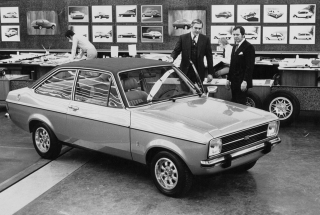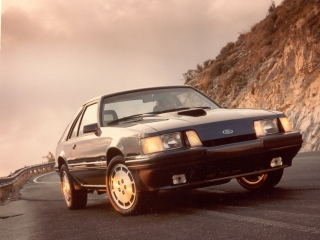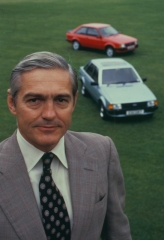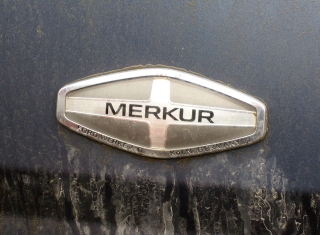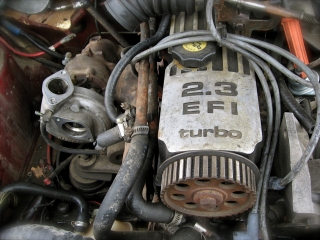Ford of Europe, from about 1975 on, was considered a training ground for Ford Motor Company’s highest-potential executives, engineers and designers. Succeed over there, in that cauldron of competition against Fiat, VW, Renault, Peugeot-Citroen and GM, and you MUST be smart! Or willing to work 20 hours a day, and seven days a week. That was the thinking.
Over the long haul, Ford of Britain and later Ford of Europe had sent cars to America, starting in the 1950s with the Consul and Anglia, and later the Cortina, Capri, and Fiesta, but with each succeeding car program, it got more expensive to Americanize or federalize each car, narrowing profit margins and chewing up valuable engineering time. But, if a high-volume car could be Americanized and federalized successfully, the program might be enough to punch somebody’s ticket on the train to the top.
One of the Engineer/MBAs who had had a successful run at Ford of Europe was Donald E. “Pete” Petersen, who by March of 1980 had been named president and CEO of Ford Motor Company. He was a tall, slender ex-Marine officer, and he had seen a great deal that he liked while working in Europe.
In 1982, the car design world got a big shock with the introduction of the Audi 100, called the 5000 here. It was the first full-on aero production car the world had seen since the Chrysler Airflow in 1934, with flush glass, aero mirrors and a shape that would draw the eye like Madonna or Cindy Crawford, at the time.
Not too long after that, Ford introduced the Sierra, a production car based on the Probe III concept vehicle develop by Ford and its Ghia studios in Turin, Italy, introduced in 1981.
Sierra was a whole new line of mid-sized cars designed to replace the Taunus and Cortina. Sierra came as a 5-door hatchback sedan and a station wagon, with a grille-less front end, pulled-in fenders, flush headlamps and a rounded roof. A three-door coupe came a year or so later. Some Americans thought Sierra was a rip-off of the Audi, but even a cursory glimpse shows that the two cars are not at all alike. The XR4i, the performance coupe version of the Sierra, with its bi-wing rear spoiler and big, thick, forward-leaning C pillar, looked like nothing else on the road.
The Sierra sold in Europe with a wide range of 4-cylinder gasoline and diesel engines and a 2.8-liter Cologne V-6, but did not excite the market at first. Some versions were available with all-wheel-drive, called XR4X4, and in South Africa, the car could be ordered with a 302 V-8, and was called XR8.
The Ford of Europe boss was a guy named Bob Lutz, who would later return to Ford North America to run the truck business, then on to Chrysler, then General Motors. The chief designer at the time was German ace Uwe Bahnsen, assisted by Frenchman Patrick le Quement. Sierra would ultimately be produced in England, Germany, Belgium, South Africa, Argentina, Venezuela and New Zealand. It was produced in a huge number of variants over a ten-year period, and made a great deal of money for Ford.
In North America, Ford was enjoying the success of the small Tempo and Topaz and the first of the aero Thunderbirds, selling tons of trucks and Town Cars for huge per-unit profits, and contemplating the rest of the 1980s. Ford’s racing organization, formalized in 1980 as Special Vehicle Operations or SVO, was headed up by German racing executive Michael Kranefuss, and part of his job was to create exciting street cars from the parts on hand.
SVO’s first attempt at that was the Mustang SVO, using a turbocharged version of Ford’s cooking 2.3-liter engine, fitted with electronic fuel injection and an big intercooler, with tire, brake and suspension upgrades to match its 175 horsepower output and an offset functional hood scoop that would help it look different from the Mustang GT V-8.
Naturally, the Lincoln-Mercury dealers would have liked something hot like the SVO to sell, but there wasn’t anything in the plans. Until someone high up in the company suggested bringing the Sierra XR4i coupe into the U.S. and using the same 2.3-liter engine as the SVO carried, without the expensive intercooler. Someone. Okay, it was Bob Lutz.
The U.S. car would have a cool, driver-centered dashboard and instrument panel, leather seating for four, lower body cladding, and a red stripe in the cladding. The underpinnings would be largely left alone. The featured color would be silver. So, the plan was to hire an outside firm, namely Karmann of Germany, to build the 2.3 turbo-powered Sierra XR4Tis, to give the cars some handbuilt panache and to take the production headaches out of Ford’s existing production system. The plan gathered momentum quickly.
At one point in the program, though, it was suggested by no less a personage than Edsel Bryant Ford II, who was then the marketing guy at Lincoln-Mercury Division, that perhaps a South African-style 302 V-8 might be a better way to go, and at his direction, Ford built two prototypes using the latest version of the U.S. 302, one manual and one automatic. After some fairly rigorous testing, during which the cars proved too nose heavy and cumbersome for comfort, the company went back to Plan A.
But there was a problem. The car couldn’t be sold as the Sierra in North America because GMC had been using Sierra for pickups for years and Oldsmobile had introduced a Ciera version of the Cutlass in 1982, and by 1985, the scheduled introduction year for the new Ford of Europe car, the name, spelled differently but pronounced the same, would be a marketing problem.
The problem trickled its way all the way up to the top of the company, to the product committee, and it was decided very quickly by Pete Petersen, the CEO and Ford of Europe veteran, that the car would be called the Merkur XR4Ti, using the German word for Mercury as the brand name, and adding a capital T for turbocharging to distinguish the car from the European XR4i. Now I ask you, who was going to argue the name with the CEO in those meetings, especially an ex-Marine whose nickname was “The Smiling Cobra?”
It was further decided that a new silver-and-black Merkur logo would be designed for use on the nose and tail of the car, and that every Lincoln-Mercury dealer who signed up for the new Merkur franchise would add one or more of these logos to his dealership signage. Nearly everyone who was presented with the name early on in the program had no idea what the name meant, nor how it was pronounced in German, usually pronouncing it MERKer.
Would the entire program have been better off if the car had simply been called the Mercury XR4Ti? It had worked previously with the German-built Capri, and would work again with the Australian-built roadster, but this time, it was to be Merkur, because the boss said so.
As the production, sales, franchising and marketing pieces started to come together into a master plan, the Ford Product & Technology Public Affairs team was called in to plan and execute the launch of the new Eurocar to the American and Canadian automotive media.
How about this? we said. How about we get a European driver to help us introduce the car to the media? How about three-time Formula One world champion Jackie Stewart? He was already shilling for the company on a number of fronts, everybody knew him from his racing and broadcasting careers, and if he told the media the car handled great, who would dare challenge him?
Jackie, at that time, got US$5000 per day, plus first-class round-trip air fare from his home in Switzerland, including crossing the water on the supersonic Concorde. This was going to be expensive!
A small handful of XR4Tis arrived from the assembly plant in Germany, and they were examined inside and out by Ford’s crack team of press-car preparers at their shop on Michigan Avenue. Everything on each car was “optimized” for best performance, and each car was test-driven by a handling expert from SVO.
The invitations went out, and the responses came back. Every car magazine worthy of the name at that time would get a chance to drive the car. No websites, no bloggers, just ink-stained wretches from half a dozen top car magazines. No lifestyle journalists, nobody from the business magazines.
It was further decided that for the media launch, Ford would use the gigantic proving grounds north of Detroit at Romeo. It had enormous elevation changes, a five-mile oval for high-speed testing, two long straightaways, and a very challenging and hilly road course, a far cry from the relatively flat and dinky test track in Dearborn. Hotels, airport transportation, tents, catering, and the cooperation of the Romeo staff (meaning put away all the other prototypes for the day so the media can’t see them driving around) were all arranged.
When the magazine reports came out, the Merkur XR4Ti got pretty much rave reviews for its zoomy styling, good power, good seats, and very good handling. The 0-60 mph times were all in the low-seven-second bracket, the magazine mavens seemed to be satisfied, and the Merkur brand was well and truly launched in the US of A.
Later on, when the magazines each got their own Merkur XR4Tis to test on their home tracks, most of them noticed a considerable deterioration in acceleration performance, and the fall-off was duly noted in the later stories. Apparently the careful preparation of the engines and turbo systems (okay, full-on blueprinting) in the small fleet of launch cars used on the Jackie Stewart program had come around and bit us in the ass. Still later, some quality issues came up, and there were a few recalls here and there.
In that first year on the market, only about 9000 cars were sold against an annual financial planning volume or FPV of 20,000 units. Between 1985 and the XR4Ti’s last year, 1989, fewer than 45,000 units were sold, and the program was stopped.
The next car in the new line was a complete departure, a luxury sedan, the Merkur Scorpio, based on the Ford of Europe Scorpio and sporting a 2.9-liter V-6 engine that was far too small and weak for such a heavy luxury car. It was a dismal failure in the U.S. in spite of its excellent exterior and interior design. By 1990, the dealers who had signed up were taking their signs down.
Some 20 years on, after three abortive attempts to bring the Ford worldwide design and production network together into a cohesive, productive whole, the Boeing outsider, chairman and CEO Alan Mulally, has finally done it, creating One Ford from the ashes of all the previous programs, and the new Fiesta is the first fruit of that Europe-to-America-with-no-changes idea. We shall see what happens now.
About the author. Jim McCraw was editor of Super Stock & Drag Illustrated, editor of Hot Rod, and executive editor of Motor Trend. He worked for Ford Motor Company between 1983 and 1990 as a product launch and motorsports specialist, including a 2-1/2-year stint at Ford of Europe. During that time, he helped to launch the aero Thunderbird, Tempo and Topaz, Taurus and Sable, Mustang SVO, Lincoln Mark VII, the Australian-sourced Mercury Capri, the Merkur XR4Ti, Sierra Evolution I, Sierra Sapphire, the Sierra-based P100 pickup truck, Sierra Cosworth, Ford Scorpio, and Ford Fiesta.



















